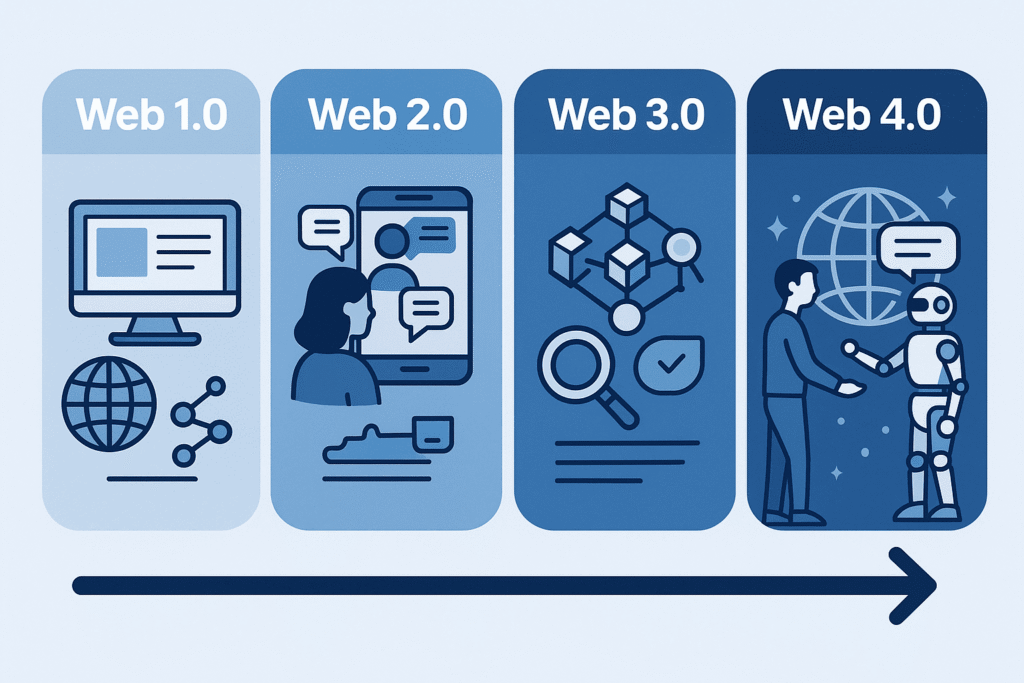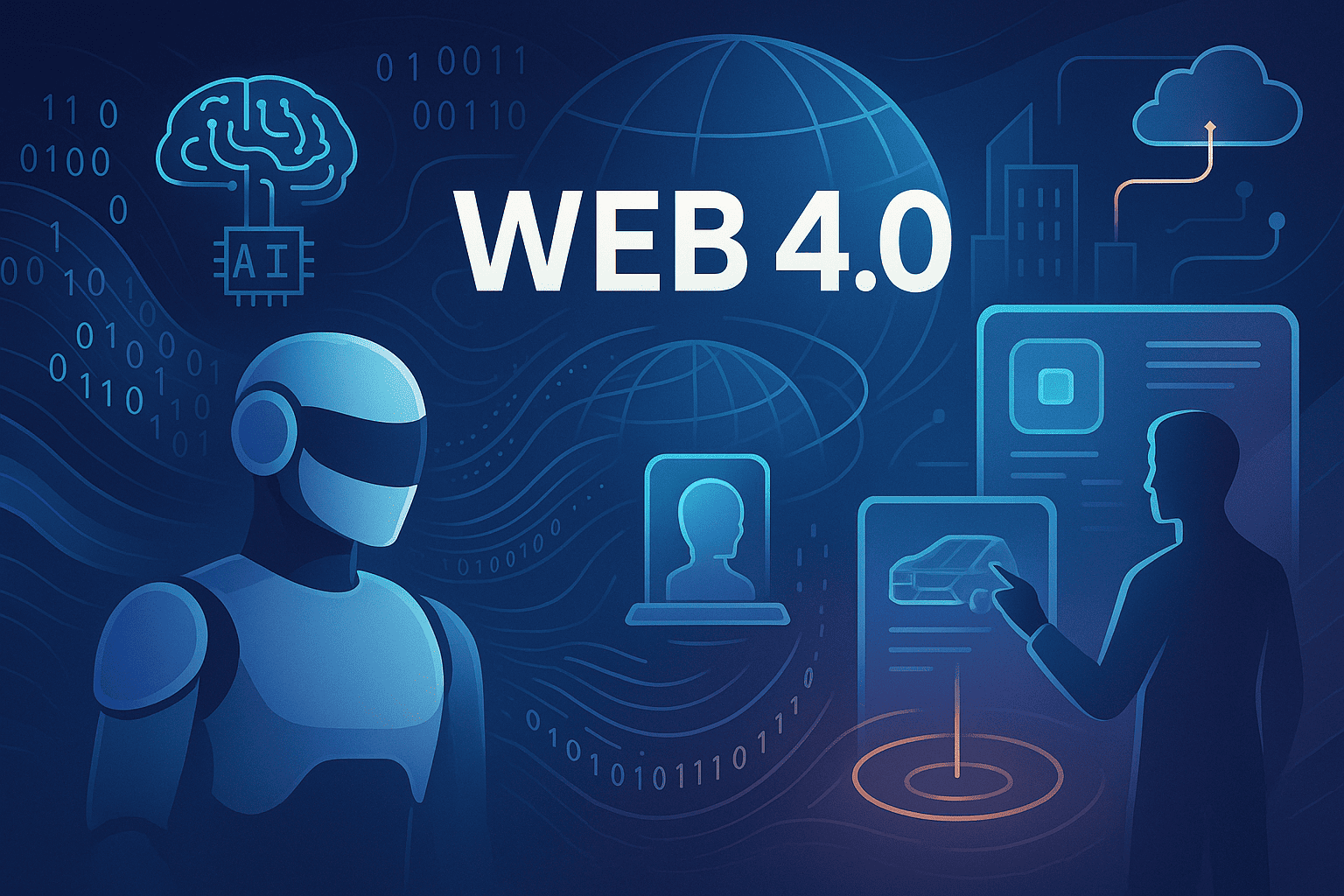The internet has evolved from simple static pages to intelligent, interconnected digital ecosystems. Today, the next major stage; Web 4.0 is emerging. It aims to blend humans, machines, data, and the physical world into a seamless, intelligent web experience. This article breaks down what Web 4.0 means, how it evolved from Web 1.0 to Web 4.0, its core characteristics, and real-world examples that make the concept easier to understand.
Table of Contents
- What Is Web 4.0?
- Key Characteristics of Web 4.0
- Evolution of the Internet (Web 1.0 to Web 4.0)
- Examples of Web 4.0 Concepts
- Why Web 4.0 Matters
1. What Is Web 4.0?
Web 4.0 is the next-generation internet built on intelligent connectivity, where AI-driven systems, real-time data, digital twins, robots, and smart devices work together to provide highly personalized and autonomous experiences. Unlike earlier versions, Web 4.0 is not just about information or interaction; it focuses on creating an integrated digital-physical world.
The concept is sometimes called “Symbiotic Web,” because users and machines will interact continuously, learning from each other and improving automatically. This allows services to anticipate user needs, automate decisions, and deliver seamless cross-platform experiences.
2. Key Characteristics of Web 4.0
Web 4.0 introduces several advanced features that make the internet more intelligent, autonomous, and interconnected. These characteristics help define what the next digital era will look like.
a) Human–AI Symbiosis
Web 4.0 aims for natural collaboration between humans and AI systems. Assistants like GPT-powered agents or autonomous robots will understand context, intent, and preferences deeply to help users perform tasks effortlessly.
b) Fully Connected Ecosystems
Smart devices, IoT sensors, cars, appliances, healthcare systems, and industrial machines will connect seamlessly. Everything will share data in real time to enhance automation and decision-making.
c) Emotional and Context Awareness
AI systems will analyze voice, behavior, mood, and biometric signals to understand user emotions and situations. This enables more empathetic and adaptive responses.
d) Real-Time Data Integration
Web 4.0 systems can combine data from physical sensors, digital platforms, cloud databases, and user interactions instantly, enabling decisions without delay.
e) Digital Twins Everywhere
Physical objects such as cars, factories, humans, cities; can have digital replicas that simulate scenarios, predict outcomes, and automate improvements.
f) Highly Personalized Experiences
Services tailor themselves automatically based on behaviors, lifestyle, preferences, and goals, creating unique user journeys in education, healthcare, entertainment, and productivity.
g) Multi-Modal Interfaces
Users interact through voice, AR/VR, brain–computer interfaces, and natural gestures; making technology more immersive and intuitive than ever.
3. Evolution of the Internet (Web 1.0 to Web 4.0)
The journey from Web 1.0 to Web 4.0 reflects a shift from static information to intelligent, autonomous ecosystems.
Internet Evolution in Tabular Format
| Web Version | Time Period | Key Idea | Features | User Role |
|---|---|---|---|---|
| Web 1.0 | 1990s | Static Web | Read-only websites, no interaction, HTML pages | Consumer of information |
| Web 2.0 | 2000–2010 | Social Web | User-generated content, social media, blogs, apps | Creator + participant |
| Web 3.0 | 2010–2023 | Semantic & Decentralized Web | AI search, blockchain, crypto, smart contracts, personalization | Owner of data + active collaborator |
| Web 4.0 | 2023–Future | Symbiotic & Intelligent Web | AI agents, digital twins, IoT integration, automation, context awareness | Connected partner with AI & machines |

4. Examples of Web 4.0 Concepts
Web 4.0 is already visible around us through emerging technologies that combine intelligence, connectivity, and real-time automation.
a) Autonomous AI Agents
Intelligent assistants that perform tasks independently such as planning schedules, analyzing data, managing logistics, or making purchases.
b) Smart Cities with Digital Twins
Entire cities can have digital models to optimize traffic, energy usage, pollution levels, water systems, and emergency management.
c) Autonomous Vehicles
Cars communicate with each other, traffic signals, weather systems, and road sensors to navigate safely without human control.
d) Personalized Healthcare Ecosystems
Wearables and IoT devices track health in real time, predict risks, and coordinate with AI doctors or hospitals automatically.
e) Immersive Mixed Reality Experiences
AR glasses or VR environments merge digital and physical spaces for shopping, education, remote work, and training.
f) Industry 4.0 and Smart Factories
Machines collaborate with robots and AI systems to automate production, predict failures, and customize manufacturing.
5. Why Web 4.0 Matters
Web 4.0 promises to create a smarter, more responsive, and more connected digital world. It transforms how people work, learn, travel, receive healthcare, and interact with technology. The symbiotic relationship between humans and machines makes everyday tasks more efficient, reduces errors, and opens opportunities for new industries. As this evolution continues, Web 4.0 will shape an era of intelligent automation and seamless digital-physical integration.
Summary
Web 4.0 represents the next major leap in the internet’s evolution. It builds on decades of progress; from static pages to social platforms to decentralized networks, and now moves toward intelligent ecosystems driven by AI, automation, and real-time data. With features like emotional intelligence, digital twins, IoT integration, and multimodal interactions, Web 4.0 promises a future where humans and machines work together seamlessly.
FAQ
1. Is Web 4.0 already here?
Web 4.0 is emerging but not fully implemented. Many technologies like AI agents, IoT networks, autonomous vehicles, and digital twins are early indicators of Web 4.0. Full adoption will take several years as infrastructure expands.
2. How is Web 4.0 different from Web 3.0?
Web 3.0 focuses on decentralization, blockchain, and semantic understanding of data. Web 4.0 goes further by enabling intelligent, autonomous, and real-time interaction between humans, AI systems, and physical devices.
3. Does Web 4.0 require advanced hardware?
Yes, to some extent. Devices need better sensors, connectivity, and processing power to support real-time data sharing and AI-driven decisions. However, many capabilities will come from cloud and edge computing.
4. What skills will be important in the Web 4.0 era?
Skills in AI, machine learning, robotics, IoT, cybersecurity, data analytics, AR/VR, and human–machine interaction will be highly valuable. Creative problem-solving and adaptability will also matter as automation increases.
Thanks for your time! Support us by sharing this article and exploring more AI videos on our YouTube channel – Simplify AI


Leave a Reply